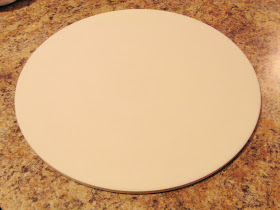[ML wants me to write chipotle peppers, but that's not it.]
The pizza stone. Yes, that flat ceramic circle that helps evenly distribute heat, builds a heat mass in your oven, and absorbs moisture so that your crusts are always perfectly cooked and crispy. Pizza is, after all, only as good as its crust.
If you don't have a pizza stone yet but aspire to make pizza, go get one. Now. It will be the best $20 you ever spend in your pizza-making career. And even if you don't end up making much pizza, it also comes in handy for roasting veggies and meats to perfection.
This is a new, unblemished pizza stone. (Our second one, for when we have company.) It's so clean and shiny. Almost immodest.
Some day it will look like this:
THIS is our old, much-used pizza stone. The surface is nicely seasoned, meaning it has absorbed all kinds of oil, giving it a perfect non-stick surface -- much like a cast iron skillet. (The yellow flecks are bits of toasted flour from the last pizza we made.)
We offer a few tips and tricks for working with your new (because you just went and bought one!) pizza stone:
- Avoid any drastic temperature changes in order to prevent cracking the stone. Always start with it in the cold oven and preheat it along with the oven. Allow it to cool completely before attempting to clean it. Never put anything refrigerator-cold in contact with its hot surface.
- The stone will season itself over time. However, to prevent sticking in the meantime, rub it with cornmeal before you heat it in the oven. Don't ever (EVER) wash the pizza stone with soap. Dish soaps are designed to dissolve grease, but the whole point of seasoning the stone is to build up oils and grease. Instead, scrape the surface with a spatula, wipe it with a paper towel, or as a last resort, rinse it with plain old water. (Remember, cool water on a cool stone.)
- To speed up the seasoning process, we recommend trying out your favorite grilling recipes in the oven. The fats from meats and any oils that you put on vegetables will soak in and give it that slick, black surface in no time. Don't worry about bacteria -- as soon as you preheat that stone it gets far too hot for anything germy to stay alive.
- On that note, the stone itself gets much hotter than any of the other baking equipment you usually put in your oven and it holds the heat for a long time, so be careful not to burn yourself. Make sure you have a heavy-duty silicone oven mitt. OR spent another $20 and add a pizza peel to your equipment list. The flat wooden or metal paddle is perfect for sliding pizzas onto and off of the stone, or for lifting and moving the entire stone.
Good, now run along.





By the way, we have typically found good deals on pizza stones from discount stores like Big Lots or bulk stores like BJ's or Sam's Club, so keep your eyes open the next time you're there!
ReplyDelete